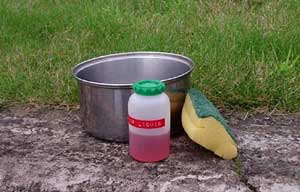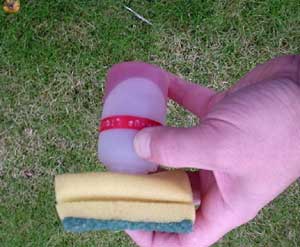Washing dishes and pots
A basic necessity that poses another challenge for those unused to doing this without running hot water, a sink and lashings of lovely soft bubbles to keep our hands all soft and gentle! It's a 3 stage process and one worth doing properly so as to avoid any chance poorly washed dishes and utensils causing food poisoning. Not a nice thought on a long trip!
1: Scrape off any remaining food scraps from your plates and pots - this can be burned on the camp fire but if you don't have a fire, then pack out the remains rather than just tipping them on the beach or the grass. Alternatively, dump in the sea for the creatures to enjoy.
2: Now get the worst of the remaining gunge off the pots and plates. A lot of muck can be removed from pots without having to use any detergent at all. Wet sand, a handful of sea-weed or a clod of wet earth makes a really good scrubber or scourer and will deal with just about anything, and is especially good for getting the soot off Trangia pots. If you avoid cooking greasy foods then the pots are so much easier to clean. Using non-stick pots really makes the job a lot easier.
3: Then you can wash the dishes and pots with hot water and (ideally) a biodegradable liquid soap. Ecover is one such and is now readily available in most supermarkets so there's no need to use ordinary detergent. There is no need to have a massive bowl full of hot water with loads of detergent squirted into it, like at home. A dixie is more than adequate, or you could even buy a special folding bowl for the job although I prefer to use mine for washing me.
Bring a small container of washing up liquid and a sponge - the sort with a scouring pad on one side. Apply just a little to the sponge pad by holding the pad to the container and upending it. You get a nice circle on the pad and let the lather build in that. The scouring pad deals with any really stubborn muck. The Lifeventure salt-water lathering liquid soap mentioned earlier could do the job too but it's really a bit pricy to use as washing up liquid!
Using this technique, the little bottle shown here usually lasts a couple of years before needing re-filling! I can easily use the same quantity in a couple of days at home!
 |
 |
Small container of washing up liquid and a sponge
scouring pad. |
You only need a tiny amount, literally the amount
left on the sponge by upending the bottle like this. |
Let's accept we're in the real world here, the aim is to minimise the impact, not attain a utopian green dream however nice that would be. We've burnt hydrocarbons getting here, we're probably traveling in craft built of glass-fibre, living in nylon tents and wearing synthetic clothing produced from hydrocarbon by-products - even breathing produces carbon dioxide and that's not good either.
If you are using a commercial domestic detergent like "Fairy Liquid", then the suggestion about using a sponge means you only use a tiny amount anyway and used water can be disposed of in the sea. If you're using proper biodegradable soap, that's even better of course. There are plenty of creatures who'll dispose of any small food scraps in the sea. But please, don't dump washing-up water laden with food scraps and detergent in a burn or stream! That burnt rice hangs around in the crystal clear stream beside the beach rather longer than you'd like if you were the one planning on taking drinking water from it that evening.
Alternatively, just scatter the wash-up water as widely as you can, perhaps in the heather or gorse. I try not to just dump it on the ground you might be camping on later that evening.
For large parties there might be merit in making a communal soak-away - a small hole on which has been laid a platform of sticks that supports a filter made of grass or bracken. Washing up water is poured through the filter to catch food scraps and that in turn can be burned on the evening camp fire and the hole filled in. Best not to bury food scraps if at all possible, as it only attracts scavengers like rats or foxes.
This technique is standard practice in Scouting for camps where there are no disposal facilities and the ground recovers very quickly indeed, with no trace of damage if the hole has been properly filled and the turf replaced. Please don't do this on machair though as it's a much more fragile soil system and doesn't tolerate having holes dug in it.
| Go Back to the previous page |
| Mike Buckley - September, 2004. | (Page updated
16-Oct-2014
) |
|